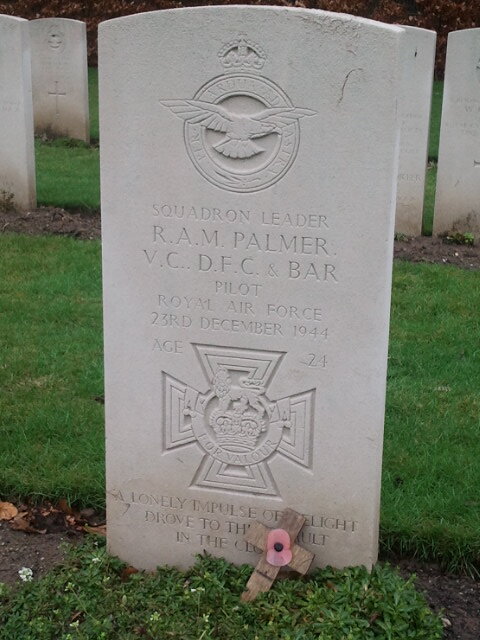Over the past few weeks I've had the opportunity to fulfill a "pilgrimage" (for want of a better word) to the grave of one of the Royal Air Force's finest pilots of the second world war. Most would immediately think of Bader, Cheshire, or Gibson (whose grave I did also visit in the village cemetery at Steenbergen in the Netherlands), but the man I refer to is certainly not as well known as any of those.
24 year old Sqn Ldr R A M ("Bob") Palmer had already completed three tours of 30 ops each (and several more) by the 23rd of December 1944, being awarded a DFC and a bar to it in the process. Starting as a Sgt pilot, he was commissioned, and eventually ended up flying Mosquitos with 109 Sqn as part of 8 Gp, the Pathfinder Force, becoming an expert in the use of OBOE, a radio precision bombing aid.
On 23rd December 1944 he led an unusual daylight raid on a German target - the Gremberg marshalling yards in Cologne. It would be his 110th operational sortie. To add to the unusual circumstances he and his navigator, 21 year old Flt Lt George Russell DFC were not flying their usual Mosquito, but a Lancaster of 582 Sqn, alongside the usual crew of Flt Lt Owen Milne.
The date is significant - the 23rd December 1944 is right in the thick of the Battle of the Bulge, and disrupting the Nazi logistical operation was critical. Cloud was forecast over the target, but as OBOE was being used, this wasn't an issue.
27 Lancasters and 3 Mosquitos took part in the raid. The cloud over the target had dispersed by the time the formation arrived, but a radio message cancelling the raid was either never received, or possibly ignored. The formation carried out the attack.
Palmer stuck to the OBOE beam like glue, despite numerous fighter attacks leaving the aircraft on fire and on two engines by the time the target was reached. Dead on target, on the OBOE signal, the bombs rained down on Gremberg; after his aircraft's bombs were released, Palmer finally lost control, and his Lancaster crashed within the perimeter of the Gremberg yards.
Palmer, Russell and Milne's crew were all killed, bar the tail gunner, who was thrown from his turret.
Palmer's Victoria Cross (roughly equivalent to the US' Medal of Honor) was gazetted on 23rd March 1945.
Quote:
Extract from “The London Gazette” of 23rd March, 1945
Acting Squadron Leader Robert Anthony Maurice Palmer, D.F.C., R.A.F.V.R., No. 109 Squadron (Missing).
This officer has completed 110 bombing missions. Most of them involved deep penetration of heavily-defended territory many were low-level ‘marking’ operations against vital targets; all were executed with tenacity, high courage and great accuracy.
He first went on operations in January, 1941. He took part in the first 1,000-bomber raid against Cologne in 1942. He was one of the first pilots to drop a 4,000-lb. bomb on the Reich. It was known that he could be relied upon to press home his attack whatever the opposition and to bomb with great accuracy. He was always selected, therefore, to take part in special operations against vital targets.
The finest example of his courage and determination was on 23rd December, 1944, when he led a formation of Lancasters to attack the marshalling yards at Cologne in daylight. He had the task of marking the target, and his formation had been ordered to bomb as soon as the bombs had gone from his, the leading aircraft.
The leader’s duties during the final bombing run were exacting and demanded coolness and resolution. To achieve accuracy he would have to fly at an exact height and air speed on a steady course, regardless of opposition.
Some minutes before the target was reached, his aircraft came under heavy anti-aircraft fire, shells burst all around, two engines were set on fire and there were flames and smoke in the nose and in the bomb bay.
Enemy fighters now attacked in force. Squadron Leader Palmer disdained the possibility of taking avoiding action. He knew that if he diverged the least bit from his course, he would be unable to utilise the special equipment to the best advantage. He was determined to complete the run and provide an accurate and easily seen aiming-point for the other bombers. He ignored the double risk of fire and explosion in his aircraft and kept on. With his engines developing unequal power, an immense effort was needed to keep the damaged aircraft on a straight course . Nevertheless, he made a perfect approach and his bombs hit the target.
His aircraft was last seen spiraling to earth in flames. Such was the strength of the opposition that more than half of his formation failed to return.
Squadron Leader Palmer was an outstanding pilot. He displayed conspicuous bravery. His record of prolonged and heroic endeavour is beyond praise 
My interest? Bob Palmer's portrait and citation hang in the hall of my old school, which he attended in the 1930s.